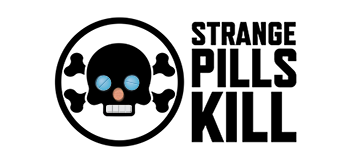

Strange Pills Kill
Nearly every fake pill today contains fentanyl. Fake pills are made to look like OxyContin®, Xanax®, Adderall®, and other pharmaceuticals. These fake pills contain no legitimate medicine and are lethal.
Fentanyl is also pressed into pills made in a
rainbow of colors to look like candy.
Don’t be fooled.
Consider any prescription pill dangerous or
deadly if it didn’t come from a pharmacist or
medical professional.
Remember: fake is fatal.
75,600,000+
I
In 2023, 75,600,000+ fentanyl-laced pills were seized, PLUS an additional 11,503+ pounds of fentanyl. This is equivalent to over 360 million potentially deadly doses. That equates to over 1 million potential accidental overdoses a day.
LEGIT OR COUNTERFEIT? Can You Spot the Difference?
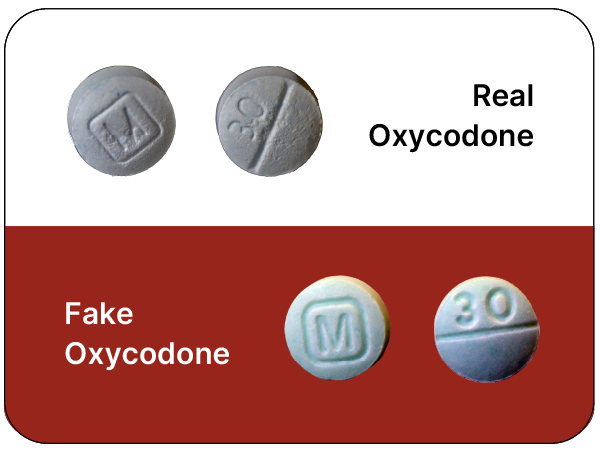
Street names include: 30s, M30S, oxy, kickers, 40s, 512s, blues

Street names include: bars, benzos, bricks, ladders, sticks, xanies, zanbars, z-bars

Prescribed as: Adderall, Ritalin, Concerta, Dexedrine, Focalin, Metadate and Methylin
Fentanyl Facts
An amount of fentanyl about the size of
two grains of salt can cause an overdose. (Source)
Fentanyl, a synthetic opioid, is:
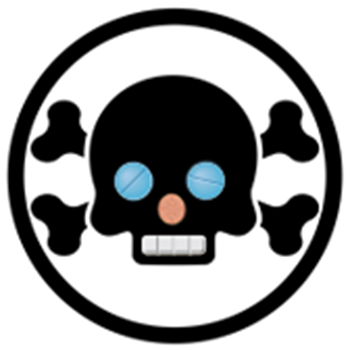
Fentanyl is involved in more deaths of Americans under 50 than any cause of death, including heart disease, cancer, homicide, suicide, and other accidents. (Source)
XYLAZINE FACTS
STREET NAME: TRANQ DOPE
Xylazine (aka tranq) is a commonly used veterinary anesthetic. (Source)
Recognize xylazine toxicity:
Overdose unresponsive to naxolone
(ex. Narcan™)
Necrotic skin wounds
When tranq is mixed with another drug (like fentanyl, heroin, or a benzo), the chance of overdose increases. (Source)
Tranq was first seen in Puerto Rico. Today, it is being found in more and more places across the US.
Effects of Opioids
on the brain
Non-medical use of opioids can be a slippery slope to:
Suicidal ideation
Injury Epidemiology reported in 2021 that “nonmedical use of prescription opioids (NMUPO) has been reported by 5-20% of adolescents (Source) and is associated with a twofold increase in suicidal behaviors among adolescents.”
Heroin use
75% of those undergoing treatment for heroin use disorder began by taking other people’s prescription drugs. (Source)
Human trafficking
25% of human trafficking survivors have an opioid dependency, according to the DEA. Human traffickers often use drugs as “bait” to recruit people who have a substance use disorder or as a means of control over their victims—to keep them “drugged out.” (Source)
Signs of Opioid Misuse
Behavioral Signs
- Isolation and secretive behavior
- Loss of interest in favorite activities
- Moodiness, irritability, nervousness, giddiness
- Emotionally erratic: quickly changes between feeling bad and good
- Sleeps at strange hours
- Misses important appointments
- Neglects personal hygiene
- Change in attitude/personality
- Drop in grades or work performance
Physical Signs
- Pupils of eyes are small, pinpoints
- Decreased respiration rate
- Sleepy or non-responsive
- Intense flu-like symptoms such as nausea, vomiting, sweating, shaking of hands, feet, or head
If you see these signs,
please ask for help.
findtreatment.gov
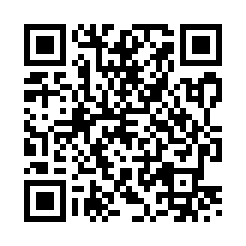
Safe Storage and Usage
– Pay Attention
Monitor how many pills are in each bottle; Keep track of refills; share the risks of unused pills with older relatives.
– Secure
Keep all prescriptions in a safe and secure place. Get a locking pill bottle. Ensure nobody, including children, can access medications without your permission.
– Tight Lids Always
Tightly close the lids of medication bottles to prevent accidental spills.
– Separate and Label
Keep everyone’s medication separate and avoid mixing them in the same bottle to save space.
– Dispose of unused
medications.
Proper Disposal
Proper Disposal Tips
Take-back Locations
90% of Americans live within driving distance of a retail pharmacy which, along with police stations, offer year-round drug disposal locations/kiosks. (Source)
At-Home Disposal
DisposeRx is a safe, convenient, quick, proven way to properly dispose of drugs at-home.
2021 Shriners Children’s Medical Center Study: Proper disposal increased from 19% to 92%
when patients were provided a DisposeRx at-home drug disposal kit paired with education. (Source)

REMEMBER: Remove any personal information prior to disposal. Make immediate disposal a priority when you no longer need medication.
Drug TaKE back day
can be everyday
Join DisposeRx in our mission to eradicate the misuse of unused medications.
The Drug Enforcement Agency (DEA) holds two Take Back Day events each year. However, every day can be take back day by visiting a kiosk or using an in-home disposal solution.
Every Day

Instructions for Safe In-home Disposal
Step 1

Add water until vial is 2/3 full.
Step 2

Empty DisposeRx powder into vial, replace cap, and shake for 30 seconds.
Step 3

Contents solidify in less than 10 minutes. Discard in trash.
Naloxone can reverse
A Drug Overdose
Signs of Opioid Overdose
If you suspect someone is experiencing an overdose, always call 911.
Naloxone is available in all 50 States
Ready the naloxone device
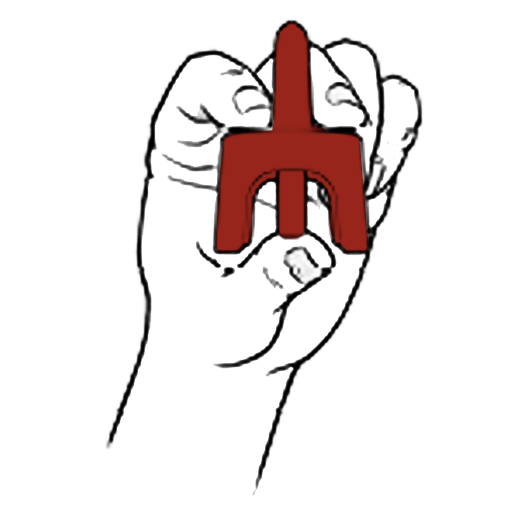
Position the device
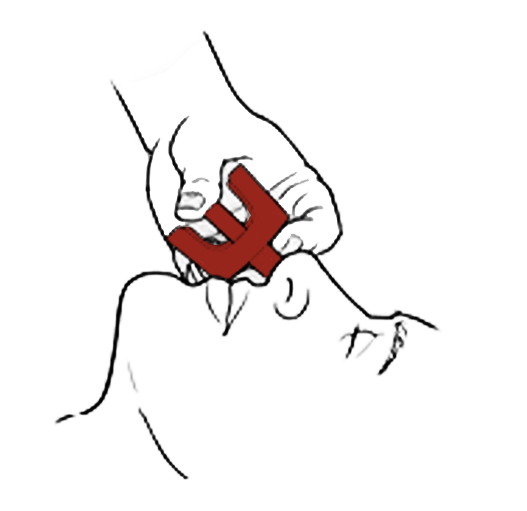
Administer the naloxone
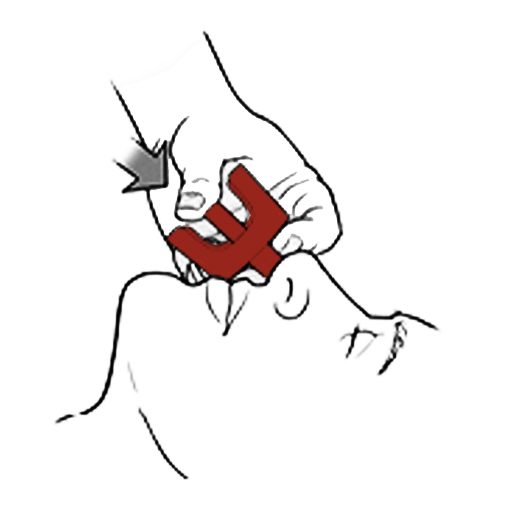
According to the CDC, “It may be hard to tell whether a person is high or experiencing an overdose. If you aren’t sure, treat it like an overdose—you could save a life.” Remember, before you administer Naloxone, call 911 immediately. Try to keep the person awake and breathing. Lay the person on their side to prevent choking. Stay with the person until emergency assistance arrives.
Fake Prescription Drugs
Percocet & Oxycodone
💊🔵🅿️🍌🏈🐤🚗🛒
Xanax
💊🍬🍫🚌
Adderall
💊 A-🚄
Dealer Signals
Dealer Advertising
🤑👑💰💵🔌
High Potency
🚀💣💥
Universal for Drugs
🍁
Large Batch
🍪
Deliver or Mail Drugs
⛽🚗📱📦🪂
Other Drugs
Meth
🔮💙💎🧪
Cocaine
❄️🌨️☃️💎🎱🔑😛🐡
Heroin
🐉🤎
MDMA or “Mollies”
🍪❤️⚡❌💊🍬
Mushrooms
🍄
Cough Syrup
🍇💜🍼
Marijuana
💨🔥🌴🌲😮🍀🥦
Fentanyl
💃🏻
Disclaimer: These emojis reflect common examples found in DEA investigations. This list is not all-inclusive, and the images above are a representative sample.
Telling teens not to do drugs is NOT the way to go here. Teens need facts rather than fearing shame, judgement, or a lecture.
As a parent, open communication is key. Encourage your child to share their concerns, and actively listen. Provide supervision to support their healthy decision-making. Spend quality time together and get involved in their school activities.
It’s vital to understand the risks of prescription drug misuse. Explain to your child:
Key Results from SAMHSA’s National Survey on Drug Use and Health:
- Start talking when they are young. As soon as your children understand what medications are, they can begin learning about safely using medications and the dangers of misuse.
- Build a relationship with your children. Show that you care about their health and wellbeing. Great communication will help your kids feel safe coming to you when they need help with a serious issue.
- Plan multiple conversations. It’s not about “The Talk;” it’s about many conversations (about many things) as they grow up. While it’s not always easy, planning to have many short, frequent discussions about the dangers of opioid misuse and abuse is the best strategy.
- Choose informal times to talk. Chatting with your teen while driving to or from school and extracurricular activities, cleaning up after dinner, or while on a walk are all good times. They will feel more at ease during the conversation if there is less eye contact.
- Resist the urge to lecture. Consider starting a conversation with asking what they know about opioids. Making them feel like their point of view is valued can result in their being more willing to engage.
- Use active listening. By reflecting back what you hear them saying (“It seems like you are feeling…”), your children will know that you understand them.
- Be empathetic and supportive. Remember that the human brain isn’t fully developed until age25: children don’t communicate the same way adults do. Let your kids know you understand andremind them that they can always count on you for support and guidance.
- Make an exit plan. Help your children create a plan for what they would do if someone offeredthem prescription pain relievers that are not theirs. Texting a code word to a family member or anyother strategy that everyone understands and agrees upon can help them get out of asticky situation.
- Be prepared to discuss any family history of substance abuse. Substance use disorders areoften genetic and exposure to substance use in the home is a major risk factor. That’s why honestconversations about unhealthy substance use, addiction, and family risk factors can help give your children the foundation they need to make the decision not to use addictive substances.
- Teach that prescriptions can be harmful if not used properly. Remind your children thatit is unsafe and illegal to take someone else’s prescription medication, even if it belongs to a friend or relative.
Join the team!
Bring Coaches vs Overdoses to your school!
Contact us about Coaches vs Overdoses to be part of this life-saving initiative. Your involvement can make a real difference in preventing overdoses and supporting those in need.




